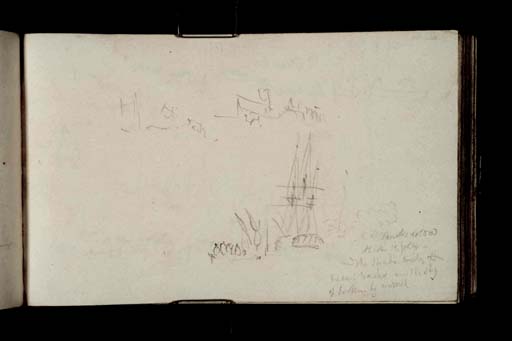Joseph Mallord William Turner The Departure of George IV from the 'Royal George' 1822
Image 1 of 2
Joseph Mallord William Turner,
The Departure of George IV from the 'Royal George'
1822
Joseph Mallord William Turner 1775–1851
Folio 72 Verso:
The Departure of George IV from the ‘Royal George’ 1822
D17634
Turner Bequest CC 72a
Turner Bequest CC 72a
Pencil on white wove paper, 114 x 187 mm
Inscribed in pencil by Turner ‘smoke coloured | from the [...] | and the shade breaking off | becomes darker and the sky | of broken by warmth’ bottom right
Blindstamped with the Turner Bequest stamp bottom right
Inscribed in pencil by Turner ‘smoke coloured | from the [...] | and the shade breaking off | becomes darker and the sky | of broken by warmth’ bottom right
Blindstamped with the Turner Bequest stamp bottom right
Accepted by the nation as part of the Turner Bequest 1856
References
1909
A.J. Finberg, A Complete Inventory of the Drawings of the Turner Bequest, London 1909, vol.I, p.613, CC 72a, as ‘Shipping.’.
1981
Gerald Finley, Turner and George the Fourth in Edinburgh 1822, exhibition catalogue, Tate Gallery, London 1981, pp.85, [204] reproduced as ‘Sir Walter Scott’s barge approaching the Royal George. Possibly associated with the unfinished oil painting, The Mission of Sir Walter Scott (Tate Gallery no.2879), intended for the “Royal Progress” series; “smoke colored and the shade breaking off becomes darker in the sky & broken by warmth”’.
Turner witnessed and drew two events in which a barge appears alongside the King’s yacht, the Royal George, in Leith Roads, so there is often a degree of uncertainty as to which event is depicted: Sir Walter Scott’s barge on 14 August, or the royal barge setting out to land at Leith on 15 August. Gerald Finley has regarded the drawing on the present page, made with the book inverted, as representing ‘Sir Walter Scott’s barge approaching the Royal George’, and therefore as related to the oil painting of The Mission of Sir Walter Scott, circa 1823 (Tate N02879).1 The sketch is certainly broadly similar in composition to that painting with the royal yacht at the right, and Scott’s barge approaching the stern from the left, with a flag, or sail hanging loosely from the mast.
There is an equal visual and compositional similarity, however, to the other unfinished ‘royal progress’ oil painting which appears to show The King’s Departure from the ‘Royal George’ in the Royal Barge, circa 1823 (Tate N02990).2 Composition ‘2’ from Turner’s proposed ‘Royal Progress’ cycle, which formed the basis of this oil, also matches the present sketch much more closely than composition ‘1’ (Tate D40979; Turner Bequest CCI 43a). Furthermore, there are several features of the drawing and the other sketches and inscriptions on the page that point to this latter subject.
First, there are two lines coming out from the port side of the royal yacht which probably represent the ‘launching crane’ used to lower the royal barge to the water. Finley noticed this feature on folio 5 verso (D17417) and it can also be seen on folio 69 (D17627), suggesting that this is the royal barge recently lowered into the water, and just setting off for Leith. There were sixteen oarsmen on that craft as well as the King and attendants and although that number cannot be seen Turner has made an effort to suggest that the boat is crowded with people.
On the starboard side, obscuring the hulls of the other vessels which can be made out by their masts, Turner drew a large cloud of smoke and added a description of the visual effect:
Smoke coloured
[?] from the [...]
and the shade breaking off
becomes darker and the sky
of broken by warmth
[?] from the [...]
and the shade breaking off
becomes darker and the sky
of broken by warmth
This is the moment that the King entered the royal barge. As John Prebble describes:
...all suddenly stilled at ten minutes to noon when a single gun was fired from the Royal George. It was immediately followed by a thunderous salute from the cannon of the Fleet, joined by the batteries on Calton Hill and Salisbury Craigs four miles away.3
Nearby pages in the sketchbook suggest that the royal barge is a likely subject. Folio 71 (D17631) appears to show the same vessel close by the Royal George, and the following page (folio 73; D17635) appears to show the same two boats from a different angle (side instead of stern on) with the landing crane again. On the verso of that page (folio 73 verso; D17636) is a sketch of the royal barge heading away from the yacht in the direction of Leith Harbour.
Finally the two sketches at the top of the page, although little more that visual notes, appear to show buildings rather than boats (although the square flag may be flying from a boat’s mast) and have the same general character to the sketch of Leith Harbour on folio 71 verso (D17632), which shows the King’s landing at Leith.
For a full list of all the sketches of the royal squadron at Leith see the King’s Visit to Edinburgh 1822 sketchbook Introduction.
Thomas Ardill
August 2008
Martin Butlin and Evelyn Joll, The Paintings of J.M.W. Turner, revised ed., New Haven and London 1984, pp.153–4 no.248a; Finley 1981, p.85. See also pp.38–43.
How to cite
Thomas Ardill, ‘The Departure of George IV from the ‘Royal George’ 1822 by Joseph Mallord William Turner’, catalogue entry, August 2008, in David Blayney Brown (ed.), J.M.W. Turner: Sketchbooks, Drawings and Watercolours, Tate Research Publication, December 2012, https://www


